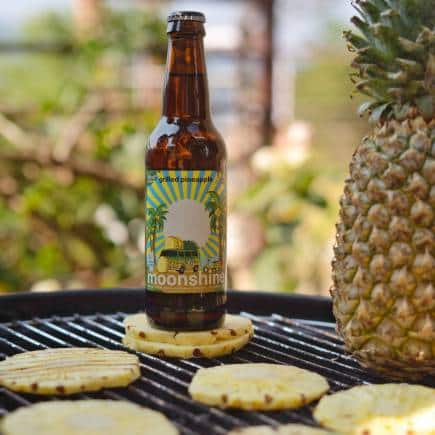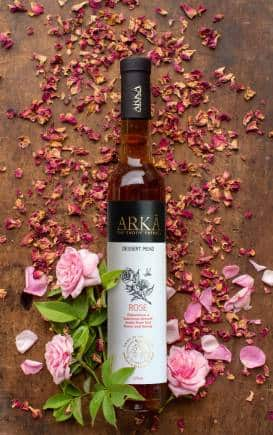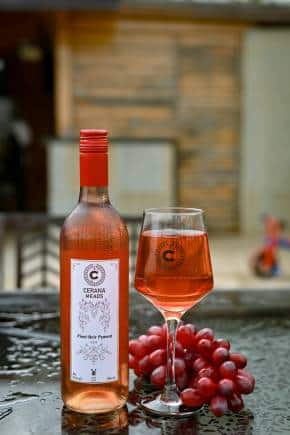Just a couple of home brew enthusiasts since the 1990s, Honnibrook Craft Meadery co-owners Michael Fagan and DJ Kurtz became friends in 2010 and started a business journey together that eventually took the surprising path of opening a craft meadery. That journey has brought growth and awards to their Castle Rock, Colo., based facility, including winning the prestigious “Commercial Wine 2021 Best of Show” trophy at the Colorado State Fair for their Peach Habanero mead.
Officially open for business in February of 2019, how has Honnibrook Craft Meadery managed to stack up the growth and awards? Fagan and Kurtz credit their unique approach to crafting mead along with using premium Colorado honey from Lockhart Honey Farms.
BREWERS APPROACH TO MEAD
Although dedicated home brewers, the duo also enjoyed making the occasional mead. At different locations, they would bring in both drinks, only to observe“ people were drinking the beer, but they were lining up for the mead.”
But it still took more to nudge them into mead making.
“We still wanted to brew beer, because beer was cool,” said Kurtz with a laugh as he and Fagan supervised the machines pumping and mixing a 55-gallon drum of Colorado honey with filtered Castle Rock water. According to the pair, drafting a business plan was the tipping point.
“We looked at (our) business plan and we needed $1.5 to $2 million dollars,” said Kurtz about the costs of a craft brewery requiring outside investment. “We realized we were going to be employees. We were not going to be owners.”
“Do I really want to work the long hours for someone else?” chipped in Fagan. “So then we were like, we are going to do mead, but still keep our beer roots.”
Keeping their beer roots meant approaching mead from a “light and refreshing” beer angle versus the traditional heavier wine style of most 10%-14% alcohol content meads.
“It was probably about two and a half years of experimentation,” said Fagan about dialling in their product while noting Kurtz’ formal training as a culinary chef was vital to the process. “We were trying to get the mouthfeel (and) the taste right,” Fagan continued. “We were taking little torpedo kegs to backyard barbecues, and when people were like, ‘that is pretty good beer,’ we knew we were onto it.”
As a result, Honnibrook’s unique style of mead is a lighter alcohol content with a fine-tuned carbonation level.
“Two and a half years of experimentation tells us 6.2% (alcohol content) is the magic number,” said Fagan. “It is where we want it to be.”
Honnibrook’s growth has caused Fagan and Kurtz to craft a new batch of mead every several weeks, versus starting off in 2019 making batches every several months. On top of finding their magic number of 6.2%, Fagan and Kurtz also credit Colorado’s Lockhart Honey Farms for their mead’s surging popularity.
“It is a super rich, monofloral honey,” said Fagan. “We get a super clean ferment and we get the same product all the time. We need the consistency.”
PREMIUM COLORADO HONEY
“That is the thing we bring to the table with our alfalfa honey is we set our bees next to large alfalfa fields and every year those fields are going to bloom,” said Leo Lockhart about their monofloral honey’s consistency. “When you set your bees up around just wildflowers and those kinds of things, you are getting a different balance of flowers so every year the flavour can be significantly different.”
A second generation beekeeper, Leo takes care of the bees while his wife Laura manages the business side. He estimates they have 1,200-1,300 hives in Colorado, while his entire family keeps about 9,000 hives in the state. While Leo and Laura also have hives in Nebraska and they move hives around the country throughout the year, he believes Colorado honey is the best.
“Colorado honey tastes so much better than anything else in the nation,” said Leo. “I go to national conferences and I always try the other honeys and I have never found another one that I would even put in the same ballpark as Colorado.”
“The area we produce is in the Arkansas River Valley,” Laura said. “It has always been a very high quality product. It seems like it is a rarer find (and) a rare taste. I am just glad it is something that works really well for making mead and that (Honnibrook) has had a lot of success with it.”
“We feel very lucky to have gotten hooked up with them,” added Leo about supplying drums of honey to Honnibrook Craft Meadery. “Their mead is great. I think that is one of the reasons they do so well is their attention to quality and caring about their ingredients so much.”
AWARD WINNING MEAD
That quality and care produced the aforementioned Commercial Wine 2021 Best of Show title at the Colorado State Fair. While Kurtz and Fagan had previously won Best of Show there in the mead category, the overall Best of Show caught them by surprise.
“That is grape wine judges telling us our mead is better than the grape wines they judged,” said Kurtz. “We earned Best of Show against the big guys. It is still hard to comprehend.”
“To win best wine in Colorado, never in our wildest dreams,” said Fagan. “It is just stuff we never expected to happen to us.”
Honnibrook was also recently ranked No. 1 in a list of “The 10 Best Wineries in Colorado” by ChoiceWineries.com. Although awards are gratifying to Fagan and Kurtz, they just love making mead.
“We always talk about (Honnibrook) as our happy place,” said Fagan while Kurtz nodded and smiled. “In our day jobs there is a lot of stress and there are lots of unhappy people. When people come here, everyone is happy. They are excited about it and we get excited about it.”
For Honnibrook Craft Meadery, using premium Colorado honey has led to sweet success.
For more information about the award winning Honnibrook Craft Meadery, as well as Lockhart Honey Farms, you can find them online at https://www.honnibrook.com and https://lockharthoneyfarms.com
https://www.thefencepost.com/news/its-colorado-mead-honey/









